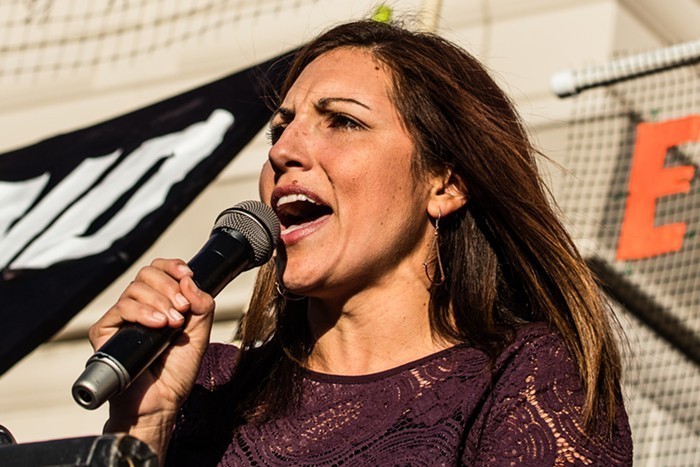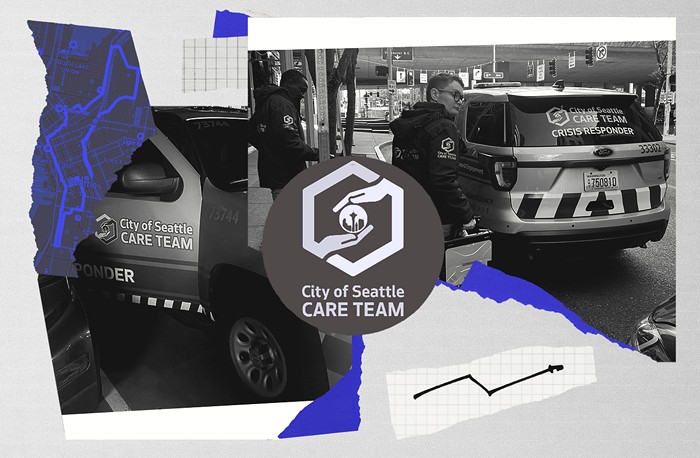No one really knows what the weather and wave conditions will be when Shell Oil's first Arctic drilling rig arrives in Seattle later this month. That's why activists are training now for rapid-response kayaks at any hour and a mass demonstration on the water. It'll be a lot different than the typical landlocked march. In addition to the need to communicate and deliver their message, they potentially face the challenge of navigating around an enormous ship with a limited ability to stop. Get too close to the ship's propeller stream ("propwash"), and kayakers might get sucked into the frigid water. Get in the way of a ship's momentum, and kayakers might topple and drown.
By creating a mass of floating protesters, activists are figuratively positioning themselves against the momentum of decisions made behind closed doors. In January, the Port of Seattle hastily okayed a deal to let Shell use Terminal 5 to moor its Arctic drilling fleet. The public had six days to digest the proposal before the port commission ushered the deal through. Not long after, and before the federal government even affirmed the Arctic leases that were up for debate until late March, Shell launched a drill ship and a drilling rig toward Seattle in preparation for its Arctic exploration season this summer.
The activists' plan isn't to block the first rig—a semi-submersible drilling unit with a 170-foot-tall derrick called the Polar Pioneer—upon arrival. "We want to escort the rig," artist-activist and Backbone Campaign executive director Bill Moyer said. The next step, however, is to make sure "the rigs never leave."
Shell's first rig is expected to pull into Seattle soon after April 12, when Marinetraffic.com shows the Blue Marlin, the ship carrying the Polar Pioneer, docking in Port Angeles. Locals will also get a heads-up on the Polar Pioneer's progress from Greenpeace, which now has six activists barnacled to the oil-drilling platform in the middle of the Pacific Ocean.
After the vessels arrive in Seattle, activists anticipate that the fleet will leave for the Arctic in mid-May. (Neither terminal lease-holder Foss Maritime nor Shell would confirm these dates.) By the time the vessels do set out, Moyer and fellow organizers want to create a "massive presence on the water" drawn from kayak-ready activists on call. They're inviting anyone to join the flotilla.
Which is how, on March 28, a bunch of local activists came to be sitting on rented kayaks in Puget Sound shouting, "Mic check! Mic check!"
Twelve kayaks had lined up in a row, the people inside them gripping each other's boats to create one large raft floating in Elliott Bay. It was a Saturday, and the activists were learning that the Occupy-style human microphone doesn't work so well on the swells of Puget Sound. While the tactic might work for a bunch of people huddled on concrete in the middle of an urban protest—out on the water, things like distance and lack of solid ground make it much harder to use.
Someone suggested twinkle fingers (up or down) to show approval or disapproval. Or maybe paddle signals. Perhaps protesters could hold their hands in a big O shape above their heads to show they were "okay" from a distance, another person suggested. That's what they used to do in the navy, anyway.
A soft breeze blew in from the south. Best to lean into it, Alki Kayak Tours' Greg Whittaker had explained to the 20-person group—of all ages and experience levels—before they set out for Terminal 5 from a West Seattle beach. If there's a north wind, things get hairier. A rare northeast wind, and that's a survival situation, he said. (That was an overstatement intended for beginners, Whittaker later clarified; for more experienced kayakers, more challenging conditions could be "fun.")
Out on the water, activist Peter Weston unfurled a sign made of bamboo poles, netting, and orange lettering and passed it down the line of kayaks. It read: RISE UP! Orange works best because it stands out from the natural environment, Moyer explained. Lisa Marcus of 350 Seattle, for example, had been working on the idea of salmon wind-sock puppets for the fleet.
The flotilla idea snowballed after a few protesters threatened, at public port commission meetings, to use their kayaks against Shell's plans. In a March 13 story, the New York Times presented the evocative image of "a flotilla of kayaks in Elliott Bay," and port commissioner Bill Bryant further popularized the phrase after audio leaked to The Stranger revealed him poking fun at Seattle public meetings to a room full of Republicans on March 19. When Bryant said the port had been threatened with a "flotilla of kayaks," the room guffawed.
For Moyer, the words that left Bryant's mouth became a mandate. "We were already thinking about a water action," Moyer said, "but when we heard him talk about kayaks and make fun of it, it was like, now we have to do it!"
Terminal 5 sits at the nexus where the west side of the Duwamish River meets Elliott Bay. "Although our police deal with a multitude of situations daily, they have not had a situation like this before [kayaks blocking large vessels]," port spokesperson Peter McGraw told The Stranger in an e-mail. Instead, the biggest environmentalist demonstrations at the port happened nearly 20 years ago, when Greenpeace activists wrapped chains around trawling boats' propellers. (In 1997, Greenpeace activists also suspended themselves from the Aurora Bridge for two days to try to block fishing boats leaving Lake Union for Alaska.)
Moyer, though, has worked with kayaks before. Back in 2009, he and a group of Vashon Island artists helped organize a "Mosquito Fleet" of kayaks to block work on a sand and gravel mine on Maury Island. The original Puget Sound Mosquito Fleet ran supplies to local docks in the 19th and early 20th centuries. Moyer's Mosquito Fleet meant something slightly different: "If you've ever doubted the effectiveness of a small, committed group of folks," Moyer said, "you've never been in a tent with a mosquito."
Port police have one vessel and 120 officers, but it's the US Coast Guard that will primarily set and enforce maritime rules. Safety and the "rules of the road" are the Coast Guard's number one priority, whether it's for the protesters or the vessels they're protesting, Lieutenant Dana Warr, spokesperson for the US Coast Guard's 13th District, said. "None of our actions are aimed at restricting lawful exercise of rights," he added.
Establishing a safety zone around the rigs could be one strategy to keep people safe, just because of physics. If a 650-foot-long ship is going at the speed of 11 knots, it would take 12 lengths of that ship to pull off an emergency brake. "That's over a mile and over eight minutes," Warr said. The Blue Marlin, the heavy lift carrier transporting the Polar Pioneer across the Pacific, is nearly 740 feet long.
Shell, too, is trying to demonstrate its ability to function under potentially dicey circumstances. In late March, the company invited federal officials to witness how well its Arctic spill containment system worked in Bellingham. In 2012, that system failed when the Puget Sound demonstration ended with the top half of the containment dome "crushed like a beer can," according to internal e-mails KUOW obtained from the Bureau of Safety and Environmental Enforcement.
Now the US Coast Guard is currently processing its annual inspection for the Arctic Challenger, the barge that would launch the system, while Shell seeks approval from the Bureau of Ocean Energy Management for its broader exploration plan.
In contrast to Shell's multibillion-dollar investment in this plan, the grassroots activists' success will rely on their ability to draw numbers of people out on the water—and their defense for doing so. There's precedent for staying on the right side of the law while doing this kind of thing: In the spring of 2013, Ken Ward and Jay O'Hara steered a lobster boat into the path of a coal shipment destined for a Massachusetts power plant. After the Coast Guard helped lift the lobster boat's anchor, the activists were charged with four counts, including conspiracy and negligent operation of a motor vessel. Then, before the trial—in which the enviros had planned to use a "necessity defense" based on the imminent dangers posed by climate change—Bristol County defense attorney Sam Sutter dropped the charges.
Back near the West Seattle beach, before prospective flotilla members gave introductions, Backbone organizer Eric Ross encouraged activists to name something that made them feel powerful. On the paddle back from the mouth of the Duwamish River and Terminal 5, he offered a chant:
Rise, Cascadia, rise!
Protect our water and skies!
Salmon and orca!
Cedar and fir!
Rise, Cascadia, rise!
Ross punctuated each line by thrusting his paddle in the air. The kayakers echoed him while navigating around a buoy full of pungent and indifferent harbor seals on their way back to shore. ![]()



















